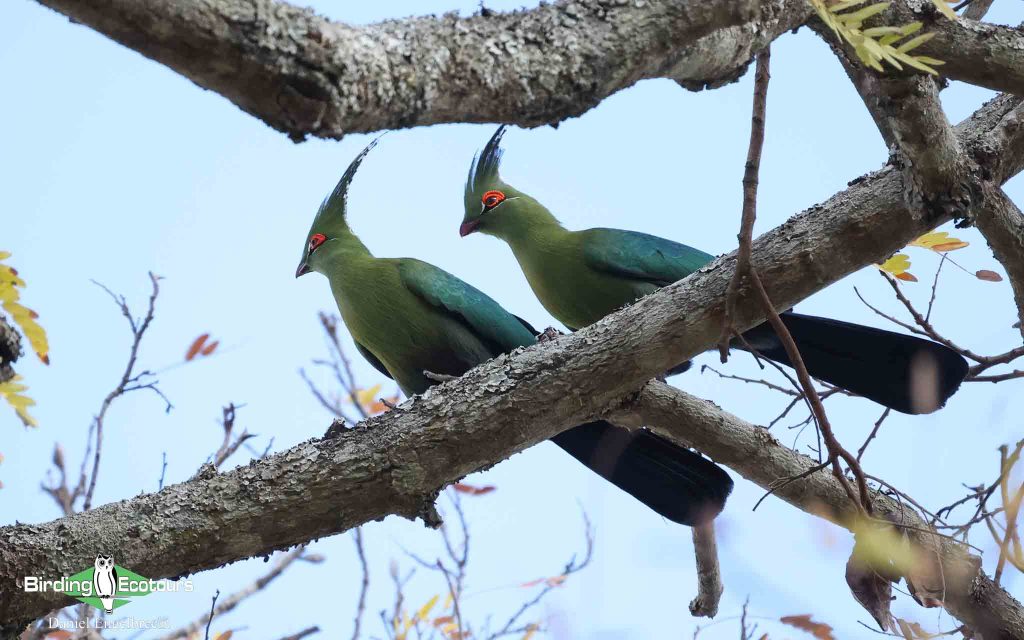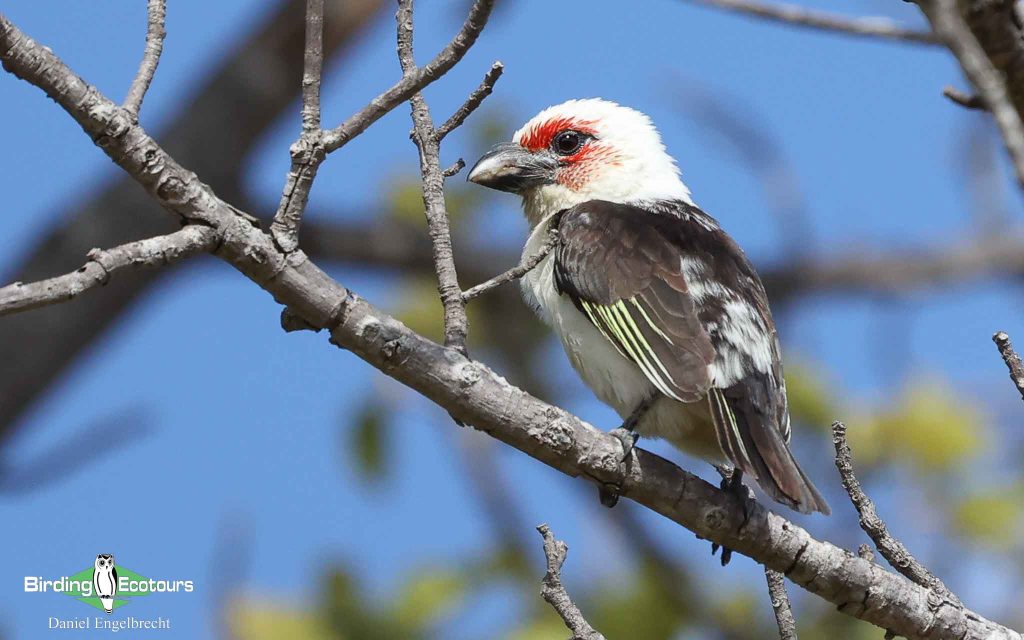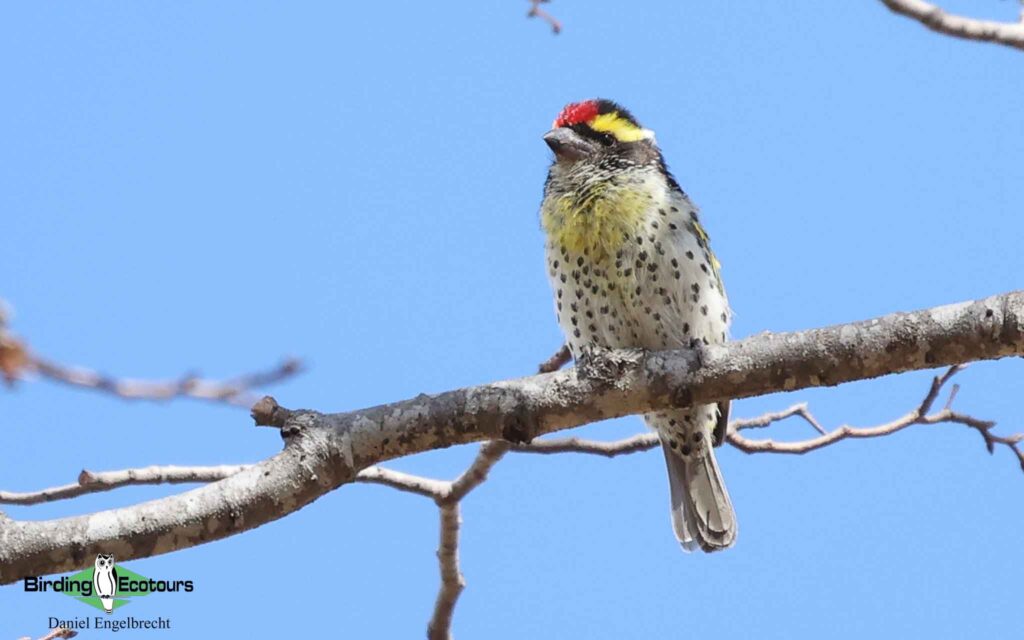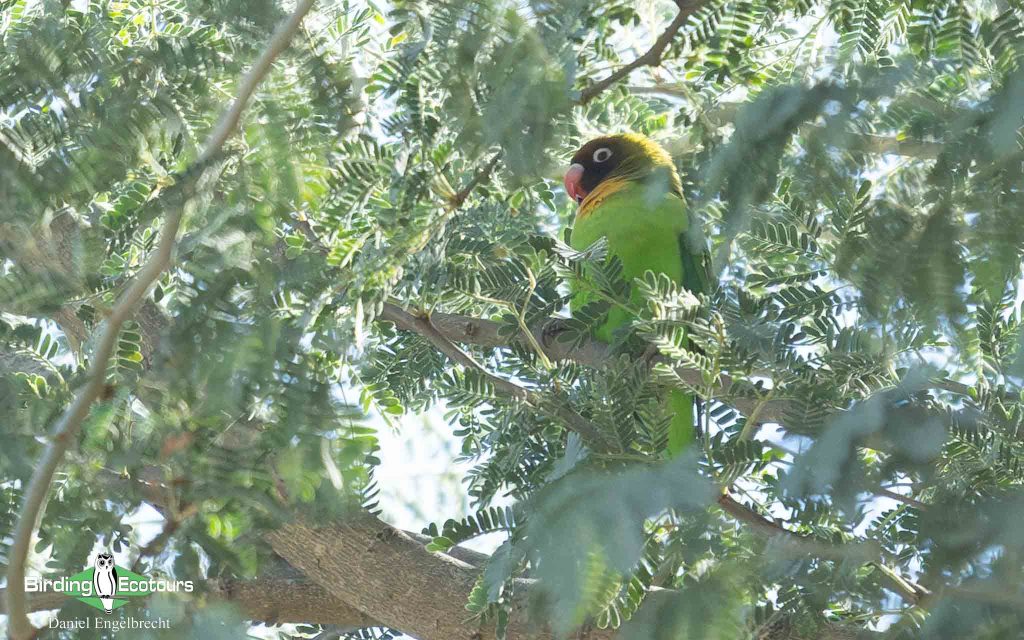Written by Daniel Engelbrecht on 14 October 2024.
Context: Daniel and Joshua had the opportunity to spend two days birding in Zambia, towards the end of a three-week scouting trip for our Namibia, Okavango, and Victoria Falls Birding Adventure tour. Daniel recounts their attempt to find the country’s two-endemic species in this blog post. Birding Ecotours does not currently offer any set departure birding tours to Zambia, however, if you would like us to set up a private trip similar to the below, please do contact us.
I was awake before my alarm went off; a noisy Natal Spurfowl had decided to use the solar lamp next to my tent as a calling post and was making his presence known. I emerged from the tent and could only just make out the opposite bank of the mighty Zambezi River in the dawn light. I walked over to the car to see that my travel companion, Joshua, was packing up his bed for the night, which involved putting the driver’s seat back in the vertical position and tossing his sleeping bag onto the back seat. We had two big days ahead of us; we would attempt to see both of Zambia’s endemic birds in 48 hours. We set off, headlights on, towards the town of Choma.
Zambia has always had an uncharted air about it for me. The country is paid precious little attention by South Africans and has been largely neglected by birders. Growing up as a birder in South Africa, I was used to seeing maps featuring South Africa’s neighboring countries (although Mozambique was severed with only the region south of the Zambezi warranting inclusion), and so Zambia represented the unexplored – the region beyond the maps. We made our way through the busy town of Livingstone at sunrise, the gateway to the iconic Victoria Falls, and changed course northwards, passing through alternating landscapes of pristine woodland interspersed with scenes typical of rural Africa. The three-hour drive to Choma passed without event, and we came to a halt at a gate that read “Bruce-Miller Farm.” Soon enough, a man emerged from the farmhouse and introduced himself as Ian Bruce-Miller; after exchanging small talk for a while and establishing that we had driven just shy of 3000 km from Cape Town to reach this place, Ian put us in touch with a local guide to show us around his farm.

We enjoyed great views of a pair of Schalow’s Turacos at a roadside stop in southern Zambia.
We drove through large expanses of open savanna dotted with isolated fig trees before getting out and starting our search. Yellow-rumped Tinkerbirds dominated the soundscape, and we soon got onto views of Meyer’s Parrots, Grey Penduline Tits, Little Bee-eaters, and Croaking Cisticolas. The first lifer for me came not in the form of our target but a Sooty Chat, and we enjoyed good views of a pair. A bird party delivered many of the usual woodland species like Southern Black Tit, Yellow-breasted Apalis, Burnt-necked and Yellow-bellied Eremomelas, Long-billed Crombec, and Arrow-marked Babbler. After about 20 minutes, we spotted a white flash darting into a fruiting fig tree. A mad scramble ensued as we attempted to find a gap in the dense foliage to confirm our suspicions. Then, out popped a gorgeous Chaplin’s Barbet onto an open perch! Success! We enjoyed walk-away views of this range-restricted Zambian endemic and followed it up with another lifer on the way back to the car – Fülleborn’s Longclaw.

The first of our endemic targets, Chaplin’s Barbet, showed well near Choma.
Target in the bag, we headed back to Choma, where we were mind-blown to discover a Mugg & Bean On The Move! Who would have thought that Choma, of all places, would be the only town Joshua could find his beloved red cappuccino after thousands of kilometers on the road? With caffeine in the bloodstream, it was time for more birding, and we decided to work a patch of degraded woodland on the outskirts of Choma. It was spectacular. Within 15 minutes, we had seen Miombo Pied Barbet (any day featuring two barbet lifers is a good one), Shelley’s Sunbird, and Miombo Blue-eared Starling. We stopped at a few more woodland patches on the way back to our campsite on the Zambezi River and had great views of a pair of raucous Schalow’s Turacos, a Shikra, and two Red-necked Falcons.

Another barbet lifer, the stunning Miombo Pied Barbet.
The wheels came to a halt on the banks of the Zambezi, this time at dusk. Joshua reclined his seat, and I fell asleep in my tent shortly after the Natal Spurfowl had signed off for the evening.
We were on the road before dawn; the Zambezi must have been stunning, but we never got to see it from our campsite. Anyway, we were now contending with what surely must rate as one of the worst roads I have ever been on. It was hard to decide if sticking on what appeared to be a lunar surface of craters and corrugations was faster than navigating through the woodland on sandy tracks running next to the road. We tried a bit of both and concluded that the sandy tracks were marginally better, both for the wheel alignment and our spines. It took us the better part of two hours to cover 80 km, but we made it to our turnoff – a nondescript sandy track leading into tall Mopani woodlands. It goes without saying that there was no cellular reception here, so we had to navigate a myriad of sandy roads using offline maps. We continued along this track for around 40 km, with Joshua’s rally skills getting us through the thicker patches of sand. For the most part, we passed through pristine gallery mopani woodlands that were only occasionally broken by small villages with friendly locals. We wanted to reach our destination as early as possible. However, we found ourselves distracted by bird parties containing boisterous Meves’s and Burchell’s Starlings, Retz’s and White-crested Helmetshikes, Bennett’s Woodpecker, Red-billed Buffalo Weaver,and even a hunting African Barred Owlet. Meyer’s Parrots were frustratingly common here, and we would find ourselves flinching at the resemblance of their screeches to that of our target.
It had taken us longer than expected to reach the section of the woodland where we would begin our search, and since we still had to cross the border back into Namibia and drive the length of the Caprivi Strip today, we did not have much time. We walked, drove, listened, and scanned, to no avail, before calling it a day. Maybe we were too ambitious; perhaps the birds were not there at the time. Feeling defeated, we turned around and started following our sandy tracks back to the main road. Typical post-dip conversations with statements like: “It has to be the weather; it’s too hot now” and “I think if we were here earlier, we would have had a better chance” occupied us as we made our way back. We then heard a high-pitched chirp, and Joshua hit the brakes. We flung ourselves out of the car (I even left my binoculars in the car) and ran toward the large ana tree from which the call was coming. A suspenseful scan with our necks craned followed before Joshua said: “I’ve got it.” Sure enough, perched near the top of the tree sat not one, not two, but three Black-cheeked Lovebirds. We could not believe how narrowly we had escaped this near-dip experience. This global mega is restricted to a small section of southwestern Zambia and instantly slotted its way into one of my all-time lifer sightings!

The mega Black-cheeked Lovebird showed itself in the nick of time!
With almost 24 hours between sightings, we cleaned up both of Zambia’s endemic birds and recorded 120 species (see our eBird trip report). Somehow, we did not feel the potholes and corrugations on the way to the Katima Mulilo border post.
